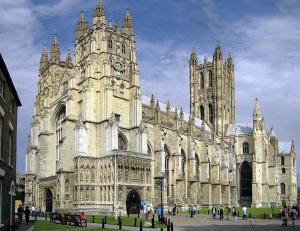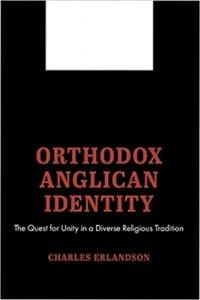 Anglican Religious Identity and History – Part I
Anglican Religious Identity and History – Part I
In an earlier blog, I offered the following one-sentence definition of Anglicanism: “Anglicanism is the life of the Catholic Church that was planted in England in the first few centuries after Christ; reshaped decisively by the English Reformation that reformed the received catholic traditions and also by the Catholic revival of the nineteenth century other historical movements of the Spirit; and that has now been inculturated into independent, global churches.”
Hidden in this very dense definition of Anglicanism is a definition of all religious identities that I’ve developed and of which Anglican religious identity is a species. You’ll notice in my definition of religious identities that the four kinds of definitions of Anglicanism I offered – normative, structural, stylistic, and historical – all make a reappearance.
Here is the model for religious identity that I’ve come up with. There are many others out there, and defining religion is a notoriously difficult thing, but here goes anyway. Put in its simplest terms, religious identities are, in part, created and maintained most clearly when there is a strong structural authority and clear norms. Stark and Finke argue, in essence, that in the absence of a strong religious authority, diversity is the natural state of things.[1] The role of structural authority in establishing and maintaining religious identities is accompanied and supported by the religious norms that interact with this authority. Often, these norms are theological in nature, although in Anglicanism the liturgical norm of the Prayer Book has a critical importance that is not present in many other Christian churches.
A brief review of the history of Anglican identity, in terms of this model of structural authority and norms, suggests that a strong authority that enforces clear norms will produce a strong and clear identity, while any reduction of the strength of either structural authority or norms is likely to lead to a weaker and less clear identity. This, in turn, suggests that a large part of the contemporary Anglican identity crisis may be due to a failure of Anglicanism to identify a strong structural authority to succeed the English state, as well as to the weakening of clear norms (especially the Bible but also the Prayer Book and Articles).
When viewed in terms of religious structures of authority and norms as they have developed over history, Anglicanism since the time of the Reformation[2] may be seen as a four act play:
Act I. 1533-1867 – Erastian Reformed Catholicism
Act II. 1867-1960s – Colonial Relationships; 4 Spiritualities
ActIII. 1960s-1998 (or 2003) – the Anglican Communion
Act IV. 1998 (or 2003) – present – Postmodern Anglicanism
In Act I, Anglicanism may be seen as “Erastian Reformed Catholicism.” I’ve already explained the Reformed Catholicism meaning of Anglicanism in earlier blogs, and “Erastian” generally means that the State has a large degree of authority over the Church. During this period, roughly from 1533-1867, Anglicanism was largely confined to the Church of England. The authority of the Church at this time was vested in the archbishops, bishops, and Convocation. However, this religious authority was a part of the EnglishStateand was interfered with by State in varying degrees. Henry VIII’s interference is only the most famous example, and it is his break with Romein 1533 that I’ve chosen to mark the beginning of this time period. The religious norms during this period, in addition to the norm of Scripture that all Christians held in common, were the State-sponsored formularies of The Book of Common Prayer and the Thirty-nine Articles. During this time, the two most important historical movements which interacted with both the structural authority and the religious norms were the English Reformation and Elizabethan Settlement.[3]
In Act II, Anglicanism can be seen as a period of “Colonial Relationships” during which four distinct Anglican spiritualities (stylistic versions of Anglican identity) emerged more clearly. This time period covers the years 1867-1960s. I’ve chosen 1867 as the beginning of this new era of Anglican identity because the first Lambeth Conference, which is a gathering bishops held every ten years to foster international Anglican identity and relationships, was held in 1867. The emergence of the Protestant Episcopal Church in theU.S.A.and the Scottish Episcopal Church in the latter nineteenth centuries necessitated some mechanism for understanding Anglicanism to be something more than just the Church of England.
During this approximately 100 year period, Anglicanism continued to spread: wherever theBritish Empirewent, so went Anglicanism. This period saw a slow but steady growth of Anglicanism in the English colonies. I’ve chosen the 1960s as the terminal point of this period because at this time the former British colonies gained their independence, which meant that new national Anglican churches for those nations had to be created.
Something to keep in mind about Act II is that just because I, Fr. Charles Erlandson, have imposed a time period comfortably nestled between the years 1867 and the 1960s and have called it the era of colonial Anglicanism doesn’t mean that the Anglican identity of Act I vanished in a poof! of smoke. In fact, the majority of Anglicans would have still been in the Church of England, under the structural authority and norms I described as adhering in Act I. The colonial churches, whether in theU.S.,Scotland, or elsewhere, would have still held to the Anglican formularies of the Prayer Book and Articles. In reality, older religious identities continue to compete and interact with newer Anglican realities: history is always a moving target, and this is one of the reasons even good scholars have difficulty in defining Anglicanism.
While the religious norms would have remained the same, the authority would have begun to change. TheState-sponsoredChurchofEnglandwas no longer state-sponsored once the American colonists gained their independence.
Perhaps more importantly, five distinct (and yet often related) Anglican ethoses developed during this time (although some had their roots in Act I). First was the development of the Evangelical identity or spirituality which grew out of certain Protestant and Reformed aspects of Anglicanism dating back to the English Reformation. But Evangelical Anglicanism was given shape especially in the late eighteenth century with the Evangelical Revival. Evangelicals appealed in particular to the Reformers’ emphasis on Scripture, and their ecclesiology and theology was shaped by men like Wesley, Whitfield, and others. Some stressed personal conversion narratives more than Anglicans had in the past, many stressed the sermon over the Sacraments, and many began to place more of an emphasis on the individual than on the Church. Over time, the Protestant aspect of Anglicanism began to become identified with Evangelical, and this Evangelical spirituality has shaped the larger Anglican identity now for more than two centuries.
A second historical movement that resulted in a distinct Anglican spirituality was the Oxford Movement, begun in 1833 and terminating in 1845 with John Henry Newman’s conversion toRome. The goal of the Oxford Movement (called by some “the Catholic Revival”) was to revive the Catholic side of Anglicanism that had been largely lost by the early nineteenth century. The Tractarians (as followers of the Oxford Movement were called) appealed not only to the precedent of the Caroline divines of seventeenth century but also to the Reformers’ use of the Fathers and Tradition. In contrast to most Evangelicals, they emphasized the Church, the Sacraments, the church year, as well as eventually developing a “higher” degree of ritualism. As the Oxford Movement continued to develop, some began to reject more and more of the Reformation and were keen on reviving aspects of medieval Roman Catholicism. This movement eventually led to the creation of the Anglo-Catholic spirituality which holds to different views than previous Anglicans of the Sacraments, apostolic succession, the saints, Mary, and the Thirty-nine Articles.
While Evangelicals and Anglo-Catholics expended their talents and energy on combating each other, a third Anglican spirituality was allowed to be born: Liberal Anglicanism. Liberal Anglicans appealed to the rational side, or to human reason. They saw precedents in the scholarship of the Humanism of the Renaissance, but they also appealed to the prevailing culture and its norms. Today’s Liberal Anglicanism is related to the Latitudinarians orBroadChurchof earlier centuries, only there is a more radical rejection of Christian orthodoxy and of Anglican norms.
The fourth Anglican spirituality, and one which I’ve seen almost no one else comment on, is what I called the Global (or “colonial”) spirituality. When Christianity spread to English colonies during the nineteenth century, during the great missionary age, often it was missions, and not churches, that were planted. These missions were typically Evangelical (much less frequently Anglo-Catholic), which meant that not the whole of Anglicanism was spread but only one particular spirituality. This was unlike the case of the English and American churches. Often, the Evangelical missions placed much less emphasis on the Church, the Sacraments, the church year, the liturgy, and other things. Each Anglican province (which emerged with independence) is its own case, and it would be a mistake to think that every colonial church looked like the Church of England or each other. Often, there was a mixture of influences, many of which may not have been specifically Anglican. The Global spirituality, therefore, while biblically orthodox, often makes use of freer liturgies and not the Prayer Book; often feels a need to compete with Pentecostal churches by becoming more like them; and emphasizes demonic activity while having tendencies toward emotionalism, power theology, and experience over theology. A specifically Anglican identity may, in fact, be relatively weak in some of these churches.
I’ll follow up with Acts III and IV next time.
[1] Stark and Finke, Acts of Faith.
[2] I’ll deal with “Anglicanism” before the English Reformation in an upcoming blog.
[3] Although I mentioned only the Church of England as part of Act I, both the Protestant Episcopal Church in theU.S.A. and the Scottish Episcopal Church were formed near the end of this time period.









